When it comes to the best marketing software to help you manage your customer experience, there are two major players in town: HubSpot and ActiveCampaign.
HubSpot is a cloud-based CRM software (customer relationship management system) designed to help entrepreneurs align their:
- Sales and marketing teams
- Foster the sales process
- Boost ROI from their inbound marketing campaigns
Similarly, ActiveCampaign combines email marketing, marketing automation features, sales automation, and cloud-based CRM strategies to help business owners enhance their customer experience.
While both automation platforms have some similarities, there are notable differences between the two. That’s why, in this review, we’re checking out what these two competitors have to offer, so you can decide which (if either) software better suits your needs.
Without further adieu, let’s dive into this HubSpot vs ActiveCampaign review.
HubSpot vs ActiveCampaign: Features and Pricing- A Quick Overview
Both HubSpot and Activecampaign’s pricing structure is built on the number of marketing contacts you have and the type of features you need.
The pricing below reflects the cost of keeping 1,000 marketing contacts on your books.
However, you’ll be glad to know that both companies have a range of free tools you can use right off the bat, which we’ll also cover below.
HubSpot
Free Tools
One of the best things about HubSpot is the variety of free marketing, sales, and general management tools it offers, including task tracking, client record storage, and automation.
Below we've listed just some of the highlights:
- Access to customizable templates for emails, landing pages, and live chat
- You can send 2,000 emails per calendar month (with HubSpot's branding)
- You can send one automated email per customer form
- You can synchronize all your advertisement campaigns
- Access to a customer database for storing all your marketing contacts and their details
- Access to a shared inbox and a team email account to enhance collaboration
- Access to CRM tools including live chat bots, in-app calls, ticketing for customer issues, and an email scheduler.
- A reporting dashboard that provides insights into your marketing performance
These features can be used with whatever pricing plan you opt for. Usually, any limits imposed on these functionalities are extended with the paid plans, which are as follows:
- Starter – from $45 a month: Here, you get a shared team inbox for managing client engagement, a social media reporting dashboard, and some basic automation tools.
- Professional – from $800 a month: This package also comes with customer support, custom reporting, and advanced marketing automation tools.
- Enterprise – from $3200 a month: On top of everything you above, you also unlock collaboration and workflow tools, as well as advanced reporting capabilities.
Regardless of which pricing plan you choose, the price increases incrementally at an additional price of $45 a month for every 1,000 contacts you have.
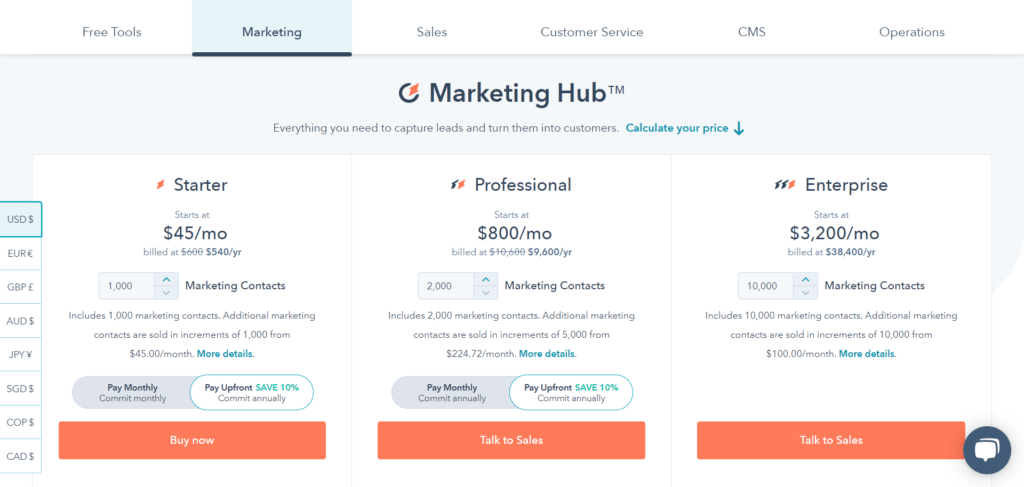
Activecampaign
Free Tools
You get access to templates for emails, ads, forums, and webinars for free. Templates are also available for your sales team to use, including sales forms, calendars, customer lists, and reporting.
Although Activecampaign's free offering is mainly template-based resources, it’s worth noting that Activecampaign also has a 14-day free trial available on all of its plans.
Again, as we compare pricing plans, the costs below are based on 1,000 marketing contacts. Though you can add more contacts at each price point:
- Lite – $30 a month: For this price, you can expect a CRM, email templates, and basic automation.
- Plus – $70 a month: You also get third-party integrations, collaboration tools, and advanced reporting.
- Professional – $187 a month: This also unlocks performance reports, predictive analytics, and onboarding for your team
- Enterprise – $323 a month: You get everything above, plus custom reporting and customer support. You also get your own email domain.
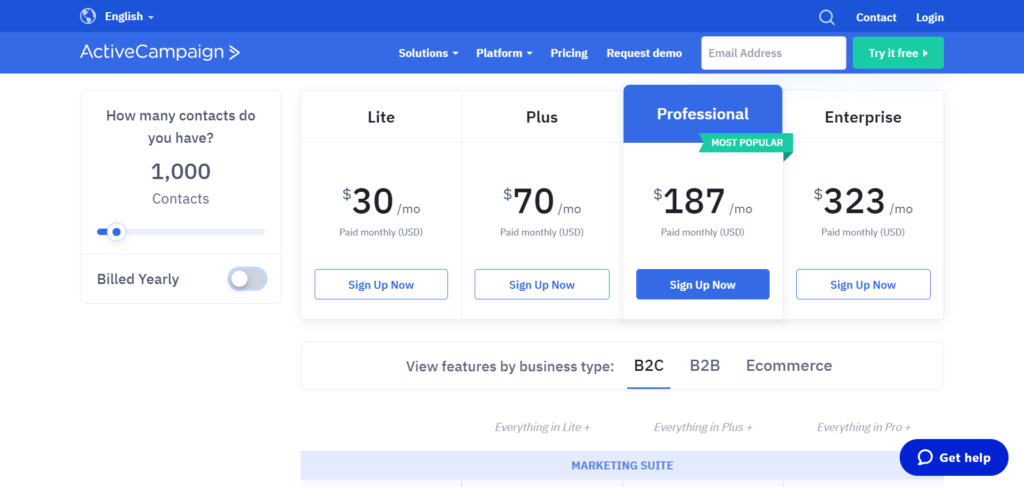
HubSpot vs ActiveCampaign: Marketing Features
Now that we have a generalized overview of each company's features let’s dive into how their marketing features compare.
HubSpot Marketing
Blog
HubSpot comes with a wholly integrated blog manager so that users can create, optimize and publish blog content from HubSpot’s CMS (more about this below). You can also schedule blog posts from the same place you manage your social media posts. From here, you can link your social accounts to your blog to automatically share content on these platforms as soon as your blogs go live.
Another excellent blogging feature is its SEO optimization. The blog page builder automatically generates on-page SEO recommendations for relevant keywords to help you outrank your competitors. What’s more, you can use HubSpot’s CMS to send automatic email notifications to subscribers when you publish new content, so your readers never miss a post.
When it comes to email marketing, creating a HubSpot email campaign with their drag and drop editor is incredibly user-friendly. You can customize the layout of these emails with images, columns, and dividers. You can also add call-to-action buttons and your own personalized branding (i.e., logo and colors).
HubSpot’s marketing hub is where you’ll find HubSpot’s marketing tools. It operates out of HubSpot’s CRM platform. From HubSpot’s CRM, you’ll find all the marketing, sales, customer service, CMS, and operations tools discussed here. More specifically, on the email side of things, you can track outbound emails, and when you receive or send an email, it syncs with your customer database inside HubSpot’s CRM. Then you can use Hubspot’s reporting functionality to oversee your open and engagement rates to get a better idea of what content appeals to which customers.
On top of that, you can even send automatic email responses and more sophisticated email sequences triggered by how a user interacts with your website. For instance, depending on previous engagement with your brand, you could send an email containing blogs posts or products that might interest them. The CRM contains contact info, including their name, other details, and prior purchases, which you can then use to send customized emails. HubSpot can even generate the most relevant subject lines, links, products, and CTAs that interest that customer and schedule an email according to when they’re most likely to open their mail.
HubSpot’s email marketing platform can be used from either your HubSpot CRM, or you can integrate it with your current email provider like Mailchimp.

Social Media
HubSpot’s social media manager enables you to handle all of your social media scheduling, posts, and marketing assets (i.e., images and videos) from one centralized location.
You can then schedule and publish content directly to:
- Your blog
The social media manager and other tools across HubSpot use machine learning technology to generate automatic insights like recommendations on the best time to post for maximum engagement. It also links to your CRM inbox. That way, when people reply to any of your social posts, blog content, or emails – you can see and monitor them all from the convenience of one inbox. Finally, your socials are also linked to HubSpot’s analytics so that you can keep an eye on metrics like visits, lead generation, conversions, etc.
ActiveCampaign
Blog
While ActiveCampaign doesn’t specifically have any blogging tools, it does offer an extensive range of third-party integrations that can manage this for you.
For instance:
- WordPress
- Shopify
- Squarespace
…To name a few!
Like HubSpot, ActiveCampaign also has a drag and drop style email builder that enables you to create branded customized emails. You can send your messages to targeted customer segments or as a general broadcast to your entire audience.
You can also set up automated emails triggered by specific customer behaviors at set stages of your sales funnel. This makes it much easier to turn interested leads into paying customers when done well.
ActiveCampaign also comes with predictive content and sending. For the uninitiated, predictive content rewords copy depending on your audience. It then sends when the recipient is most likely to engage with your email. Alternatively, emails can be scheduled in advance using third-party integrations like WooCommerce, Zapier, and Facebook.

Social media
While ActiveCampaign doesn’t allow you to publish directly to social media, it provides comprehensive tracking and automation capabilities. For example, when you link your social accounts, ActiveCampaign delivers insights into how users engage with your brand across your social media platforms. They'll also rank customer engagement accordingly.
With this info to hand, you can create personalized follow-up responses using dynamic email content that changes based on list segmentation and split testing flows. I.e., you’re better positioned to send the most effective email content for that specific audience.
On top of that, ActiveCampaign offers a visual marketing funnel and a drag-and-drop automation builder. You can automate email, text message (SMS), and Facebook ad campaigns here. Or you can generate responses based on specific user behaviors, lead scoring, and any stage of the customer lifecycle, for that matter.
HubSpot vs ActiveCampaign: Workflow and Collaboration Features
Now, let’s switch gears and compare the workflow and collaboration feature HubSpot and ActiveCampaign have to offer:
HubSpot
- Document management: You can create a library of documents for your whole team to access, update and refer to.
- Shared inbox: Benefit from a universal inbox that all team members can access
- Third-party integrations: You can send Slack messages, Zoom invites and set Asana tasks directly from HubSpot.
- Permissions: You can split up your workflow and assign assets to different team members. This empowers various department members to focus on their individual tasks while still working simultaneously to finish your projects faster!
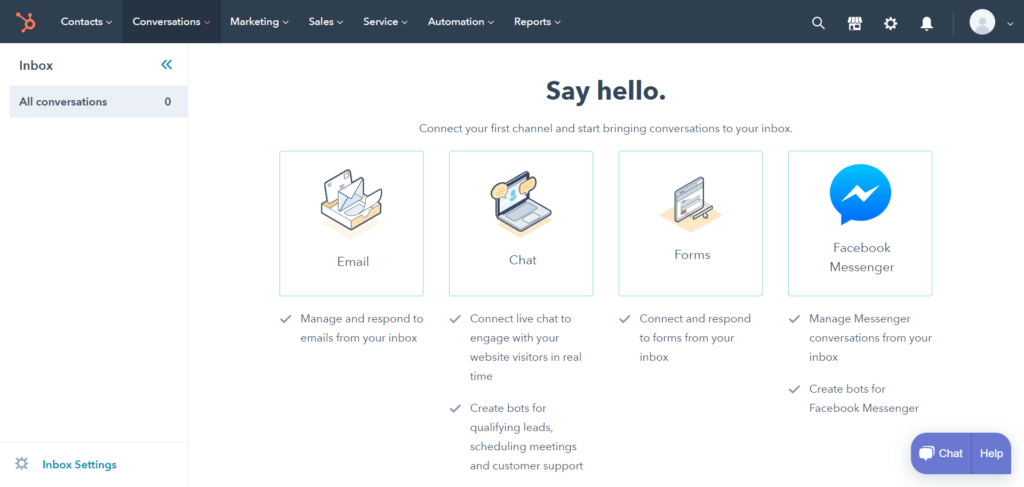
ActiveCampaign
- Shared customer/contact database: ActiveCampaign’s mobile app provides your team with access to contact information, deal history, and updates on customer activity and engagement while on the move.
- Task assignment: You can assign tasks to team members based on the prospect’s behavior.
- Permissions: You can control which team members can see which sale pipeline.
- Team messaging: Using the app, you can tag teammates in conversations and discuss ongoing deals.
- Third-party integrations: ActiveCampaign integrates with over 870 apps, including Calendly, Zoom, and Gmail.
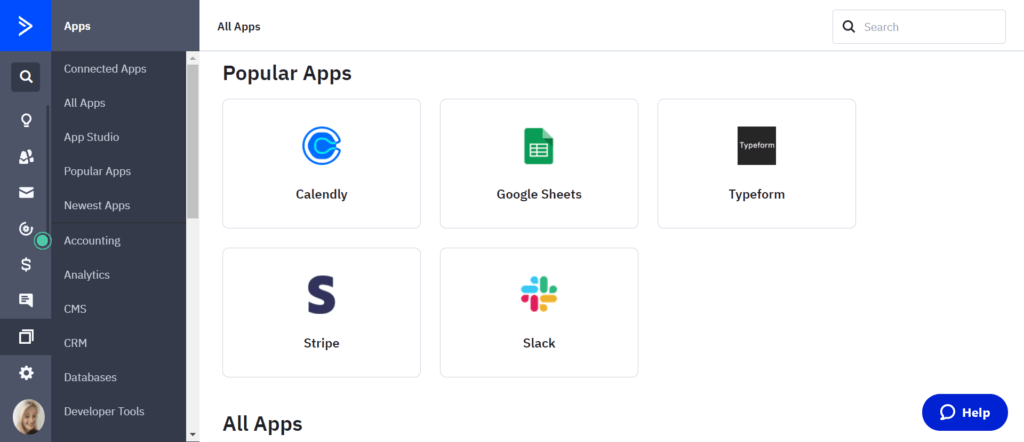
HubSpot vs ActiveCampaign: CRM
Next on our list of comparisons, HubSpot and AtiveCampaign’s CRM:
HubSpot
HubSpot’s CRM has a visual dashboard that acts as a one-stop-shop for your business's marketing, sales, customer service, content management, and business operations. As discussed, this same CRM also comes with marketing and collaboration tools. But, below, we’re focusing on features concerning sales management, customer engagement, and customer support:
Engagement
HubSpot’s customer profiling software pools insights about potential leads using the interactions they’ve had with your company’s email correspondence and website. It then calculates a score for these leads based on the engagement metrics of your choice and stores this information in a database linked with your sales and marketing suite.
Or, to engage with customers one-on-one, you can also set up a live chat and or online meetings with one of Hubspot’s third-party video conferencing integrations. For instance, G-Suite, Slack, and HubSpot.
Sales
From HubSpot’s CRM, you can track your sales pipeline performance all the way from the first interaction to after the sale. In addition, you can also monitor the efficiency of your sales efforts through email, social media, and contact forms. Lastly, you can also collate your sales documentation, including purchase orders, reports on leads, content that’s seen exceptionally high engagement, and customer profiles.
Customer Support
HubSpot’s CRM also boasts the following customer support capabilities:
- Help desk and ticketing: All customer tickets are filtered into one manageable dashboard
- Live chat and chatbot: The chatbot will direct customers to relevant self-help pages and information before launching a ticketing query or forwarding them to a live chat agent.
- Automation: HubSpot’s ticketing system automatically prioritizes and categorizes tickets. After directing the email to the relevant team member, it will inform the agent about the customer’s history, product details, and service issues. This goes a long way to ensure the agent has all the info to provide a helpful response.
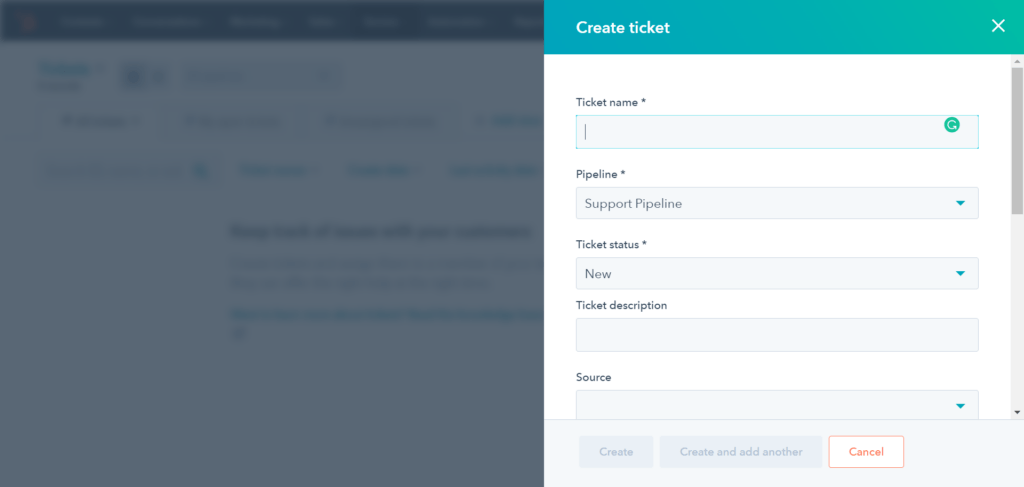
ActiveCampaign
ActiveCampaign’s CRM also comes with a contact database and comes with tools to help you automate customer engagement, sales, and customer service:
Engagement
ActiveCampaign comes with several lead engagement tools, including:
- Lead scoring: You can score customers based on their engagement, interest, and receptibility to your product. ActiveCampaign will also tell you when these scores change, so you can prioritize leads who are close to making a purchase.
- Win probability: ActiveCampaign predicts the likelihood of a lead making a sale and generates emails according to this probability.
- Visual sales pipeline: This is a pictorial diagram of where different customers are in their sales journey.
- Testing and automation: ActiveCampaign tests different sales approaches and automatically adapts to different customer behaviors.
Sales
You can monitor different sales funnel aspects, such as conversations, contact records, and site interactions. In addition, Salesforce and the plethora of other third-party integrations can provide in-depth metrics on your sales performance, including conversion rates and revenue forecasts.
Customer Support
- Help desk and ticketing: All customer tickets are filtered into one manageable dashboard
- Live chat and chatbot: The chatbot will send automated messages, collect data, and score leads on your website.
- Automation: The HubSpot ticketing system automatically prioritizes and categorizes tickets. After directing the email to the relevant team member, they’ll receive a full rundown of the customer’s prior interactions with your brand.
HubSpot vs ActiveCampaign: Reporting
Last but not least, let’s take a look at HubSpot and ActiveCampaign’s reporting capabilities:
HubSpot
With HubSpot, you can generate reports on email opens, form submissions, and website activity. In addition, with HubSpot’s Salesforce integration, you can get revenue insights about specific campaigns and team member performance.
HubSpot’s marketing reporting can also directly create detailed and visual reports from your marketing assets. This could be a website, landing page, blog post, or social media content. It can then drill down into each piece of content to see the individual contacts who have responded and how they responded to these assets and provide feedback on what is and isn’t working. For instance, HubSpot can compare vital metrics like sessions (how long people spend on your content) and conversion rates (how many make purchases) from websites similar to your own.
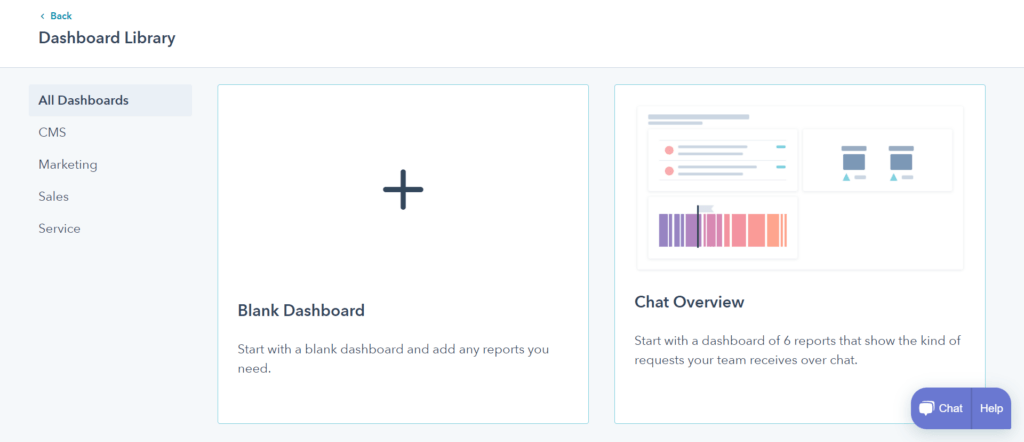
ActiveCampaign
ActiveCampaign provides comprehensive sales and marketing reporting features, including lead quality to event tracking. Some of ActiveCampaign’s more advanced reports pinpoint exactly where customers go on your site, what they engage with, how long they engage for. Then you can even set up automated events in response (such as emails or a live chat popup).
Again, you can use third-party integrations to provide more in-depth reports on sales, revenue, and customer engagement.
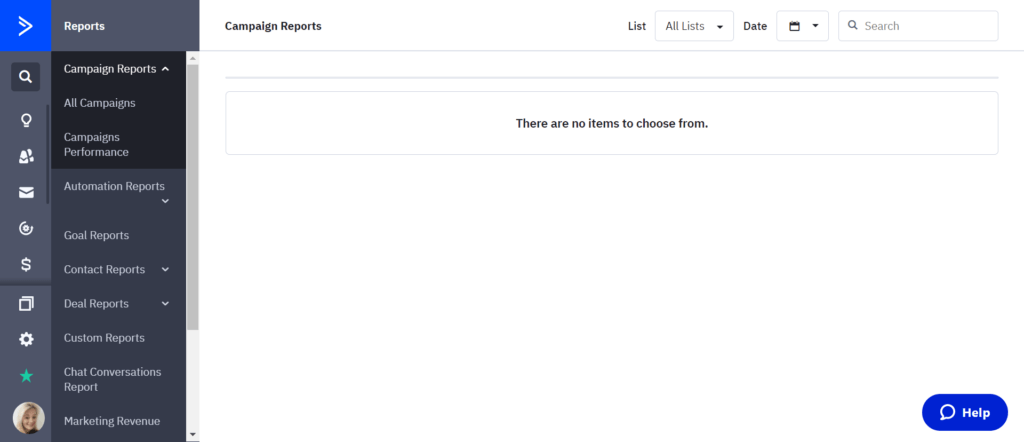
Hubspot vs Activecampaign: Our Final Thoughts
As we’ve seen, these two platforms have many similar features in common, but clearly, there are some key differences between these two digital marketing software. For example, where HubSpot leans towards providing an all-inclusive CRM platform, ActiveCampaign focuses more on automation. Mor specifically, let’s use marketing as a for instance. HubSpot has built-in tools for blogging, emailing, and social media. In contrast, we see ActiveCampiagn leans towards third-party integrations to supplement some of these marketing features.
In summary, if you’re looking to manage multifaceted aspects of your business, such as sales, marketing, and workflow, from one platform, Hubspot may be the better choice for you. However, if you're a small business focusing on a more refined sales approach, ActiveCampaign is probably the better bet.
Well, that’s all, folks, for our HubSpot vs ActiveCampaign review. We hope this article provides all the information you need to choose the platform best suited to your needs. Have you decided which software takes the title of CRM king? If so, let us know in the comments box below!




Comments 0 Responses